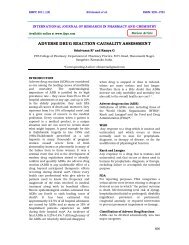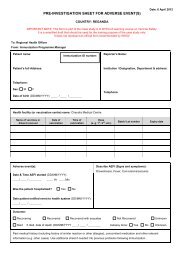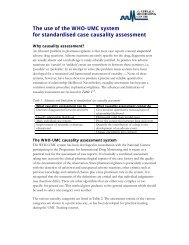00050
You also want an ePaper? Increase the reach of your titles
YUMPU automatically turns print PDFs into web optimized ePapers that Google loves.
IJRPC 2011, 1(3) Srinivasan et al. ISSN: 22312781<br />
II. Causality Assessment Between Drug and<br />
Suspected reaction 23<br />
Causality assessment is the method by which<br />
the extent of relationship between a drug and<br />
a suspected reaction is established.<br />
It is often difficult to decide if an adverse<br />
clinical event is an ADR or due to<br />
deterioration in the primary condition.<br />
Furthermore, if it is an ADR, which medicine<br />
caused it, as many patients are on multiple<br />
new medications when ill, particularly if<br />
admitted to hospital. In spite of these<br />
problems, the decision that a particular drug<br />
caused an ADR is usually based on clinical<br />
judgment alone. Studies have shown that there<br />
is a lot of variation in between rater and<br />
within rater decisions on causality of ADRs;<br />
this applies both to pharmacologists and<br />
physicians 25,26 .<br />
There are various approaches in the first<br />
approach an individual who is an expert in<br />
the area of ADRs would evaluate the case. In<br />
the process of evaluation, he or she may<br />
consider and critically evaluate all the data<br />
obtained to assess whether the drug has<br />
caused the particular reaction. A panel of<br />
experts adopts a similar procedure to arrive at<br />
a collective opinion. using algorithms<br />
including standardization of methods.<br />
Algorithms being structured systems<br />
specifically designed for the identification of<br />
an ADR, should theoretically make a more<br />
objective decision on causality. As such<br />
algorithms should have a better between and<br />
within rater agreement than clinical judgment.<br />
A number of algorithms or decision aids have<br />
been published including the Jones’<br />
algorithm, 28 the Naranjo algorithm, 27 the<br />
Yalealgorithm, 29 the Karch algorithm, 30 the<br />
Begaud algorithm, 31 the ADRAC, 32 the WHO-<br />
UMC, 33 and a newer quantitative approach<br />
Algorithm.34 Each of these algorithms has<br />
similarities and differences. And the most<br />
commonly used algorithms; the Naranjo<br />
algorithm (Fig :1) is shown below<br />
The Naranjo Algorithm is a questionnaire<br />
designed by Naranjo et al for determining the<br />
likelihood of whether an ADR (adverse drug<br />
reaction) is actually due to the drug rather<br />
than the result of other factors. Probability is<br />
assigned via a score termed definite, probable,<br />
possible or doubtful. Values obtained from the<br />
algorithm are sometimes used in peer reviews<br />
to verify the validity of author’s conclusions<br />
regarding adverse drug reactions. It is also<br />
called the Naranjo Scale or Naranjo Score.<br />
III. Documentation of ADRs in Patient’s<br />
Medical Records<br />
This aids as reference for alerting clinicians<br />
and other health care professionals to the<br />
possibility of a particular drug causing<br />
suspected reaction.<br />
IV. Reporting Serious ADRs to<br />
Pharmacovigilance Centres / ADR<br />
Regulating Authorities<br />
According to FDA, a serious reaction is<br />
classified as one which is fatal, life threatening,<br />
prolonging hospitalisation, and causing a<br />
significant persistent disability, resulting in a<br />
congenital anomaly and requiring intervention<br />
to prevent permanent damage or resulting in<br />
death 35 Hatwig SC, Seigel J and Schneider PJ<br />
categorised ADRs into seven levels as per their<br />
severity. Level 1&2 fall under mild category<br />
whereas level 3& 4 under moderate and level<br />
5, 6&7 fall under severe category . 36 (fig:2). Karch<br />
and Lasanga classify severity into minor,<br />
moderate, severe and lethal. In minor severity,<br />
there is no need of antidote, therapy or<br />
prolongation of hospitalisation. To classify as<br />
moderate severity, a change in drug therapy,<br />
specific treatment or an increase in<br />
hospitalization by at least one day is required.<br />
Severe class includes all potentially life<br />
threatening reactions causing permanent<br />
damage or requiring intensive medical care.<br />
Lethal reactions are the one which directly or<br />
indirectly contributes to death of the patient.<br />
Different ADR regulatory authorities are -<br />
Committee on safety of medicine (CSM),<br />
Adverse drug reaction advisory committee<br />
(ADRAC), 37 MEDWATCH, Vaccine Adverse<br />
Event Reporting System 38 WHO-UMC<br />
international database maintains all the data of<br />
ADRs.<br />
CONCLUSION<br />
India has more than half a million qualified<br />
doctors and 15,000 hospitals having bed<br />
strength of 6, 24,000. It is the fourth largest<br />
producer of pharmaceuticals in the world. It is<br />
emerging as important clinical trial hub in the<br />
world. Many new drugs are being introduced<br />
every year and so every health care<br />
professional must have knowledge about<br />
importance of ADR monitoring and<br />
pharmacovigilance. Every health care<br />
professional should see it as a part of his/her<br />
professional duty keeping in mind about<br />
Hippocrates admonition” at least does no<br />
harm”.<br />
609






